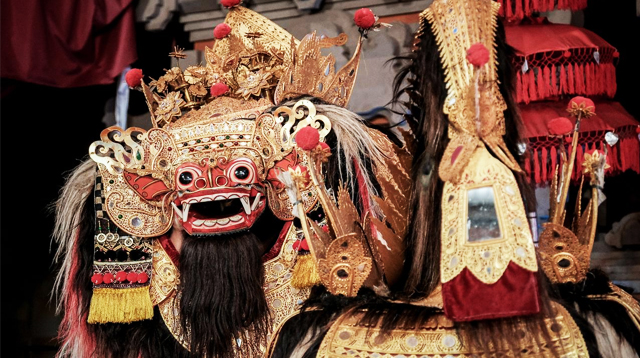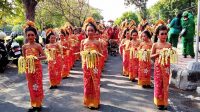THE Island of the Gods, a nickname given to Bali, is not just famous for its breathtaking beaches and lush landscapes. What truly captivates visitors, is its rich and deeply spiritual culture. The Balinese way of life is rooted in centuries-old traditions, ceremonies, and artistic expressions that are still very much alive today.
From grand temple festivals to mystical dance performances, here’s a closer look at Bali’s unique culture and traditions in brief.
- Nyepi – The Balinese Day of Silence
Nyepi, or the Balinese New Year, is unlike any other New Year celebration in the world. Instead of parties and fireworks, the entire island goes into total silence for 24 hours, starting on 06:00 until 06:00 Local Time the next morning.
When? Every March or April, depending on the Balinese calendar. This year falls on March 29, 2025.
What happens?
- The day before Nyepi, Ogoh-Ogoh parades take place, where giant demon-like statues are carried through the streets of villages and then burned to neutralize evil spirits.
- On Nyepi itself, everything shuts down—no flights, no cars, no lights, no activities—as locals and tourists alike observe complete silence.
- This day is meant for self-reflection and meditation, making it a deeply spiritual experience.
Why visitors love it: Many visitors find it fascinating and refreshing—a rare opportunity to truly disconnect from the outside world.
- Galungan & Kuningan – The Victory of Good over Evil
Galungan is one of the most important religious celebrations in Bali, marking the victory of Dharma (good) over Adharma (evil). It is a 10-day festival, ending with Kuningan, when the spirits of ancestors return to the heavens.
When? Every 210 days, based on the Balinese Pawukon calendar. This year, Galungan falls on April 23 and November 19 and and Kuningan on May 3 and November 29.
What happens?
- The most iconic sight during Galungan is the penjor—tall, beautifully decorated bamboo poles placed outside homes and temples.
- Families make special offerings to their ancestors and hold prayers at temples.
- Balinese people dress in their finest traditional attire and visit relatives to share food and blessings.
Why visitors love it: The colorful decorations, temple ceremonies, and festive atmosphere provide an authentic cultural experience.
- The Barong Dance – A Battle of Myth and Magic
The Barong Dance is one of Bali’s most famous performances, telling the legendary battle between Barong (a lion-like creature representing good) and Rangda (a witch symbolizing evil). This tourist attraction is daily performed at their respective stage.
Where to watch: in Ubud (most popular), Batubulan, Kesiman Village and GWK Cultural Park
What happens?
- Dancers in elaborate costumes perform a dramatic battle between good and evil, accompanied by a Gamelan orchestra.
- The Barong character is a mythical protector spirit, while Rangda is a terrifying demon queen.
- The story reflects the eternal struggle between positive and negative forces in life.
Why travelers love it: The costumes, storytelling, and mystical energy make it an unforgettable experience.
- The Kecak Fire Dance – A Hypnotic Spectacle
The Kecak Dance is one of the most mesmerizing performances in Bali, often performed at sunset with the dramatic backdrop of Uluwatu Temple’s cliffs.
Where to watch:
- Uluwatu Temple (most famous)
- Pura Dalem Ubud
- Tanah Lot Temple
What happens?
- Unlike other Balinese dances, Kecak has no musical instruments—instead, a chorus of dozens of men chant Cak! Cak! Cak!” in rhythmic harmony.
- The dance tells the story of the Ramayana, featuring the heroic Prince Rama, the evil King Ravana, and the monkey god Hanuman.
- The show ends with a dramatic fire performance, adding to the mystical atmosphere.
Why visitors love it: The intense chanting, fire spectacle, and sunset setting create an almost magical experience.
- Balinese Temples – The Island’s Spiritual Heart
Bali is home to thousands of temples (nicknamed as the Island of One Thousand Temples), each with its own unique charm and spiritual significance.
Must-visit temples:
- Besakih Temple – Bali’s Mother Temple perching at the foot of Mount Agung, the most sacred and mother temple of Bali, Karangasem
- Tanah Lot Temple – A temple sitting on a rock in the sea, famous for sunsets, Tabanan
- Uluwatu Temple – Perched on a cliff edge, offering stunning ocean views.
- Tirta Empul Temple – Known for its holy water purification rituals, Gianyar
- Ulundanu Beratan Temple – Floating-like temple in the Beratan Lake, Bedugul, Tabanan
Why visitors love it: The mystical atmosphere, ancient architecture, and deep spirituality of Bali’s temples make them a must-visit.
- Traditional Offerings – The Art of Gratitude
Wherever you go in Bali, you’ll see small, colorful offerings (canang sari) placed on the ground, in front of shops, house compounds or on altars.
What are they?
- Made of palm leaves, flowers, rice, and incense, these offerings are given to thank the gods and bring balance to life.
- They are placed daily by Balinese Hindus as a form of devotion.
- The act of making these offerings is called mebanten and is an essential part of daily life.
Why visitors love it: Many visitors are fascinated by the deep spiritual connection behind this daily practice.
Conclusion: A Living Culture That Captivates the World
Bali’s unique culture and traditions make it more than just a beach destination—it is a place where spirituality, art, and community thrive. From the silent serenity of Nyepi to the dramatic energy of Kecak, every tradition in Bali tells a story of harmony, devotion, and balance.
For travelers, experiencing these ancient customs firsthand offers a rare glimpse into a world that is both mystical and deeply meaningful. Whether you are watching a Barong dance, placing a flower offering, or witnessing the grandeur of Galungan, Bali’s culture will leave you in awe. (*)










